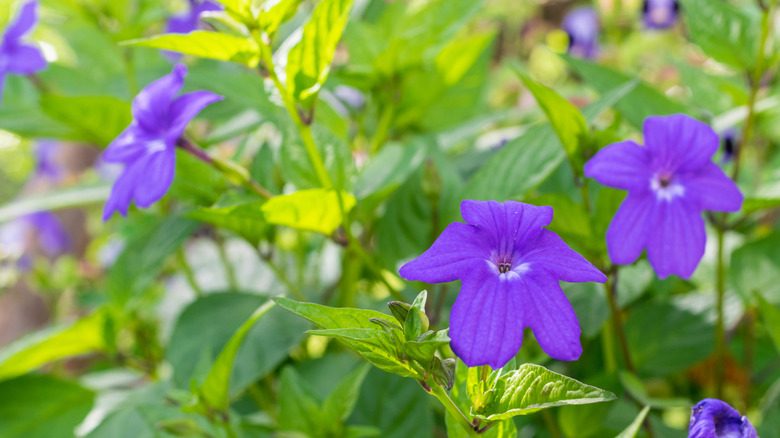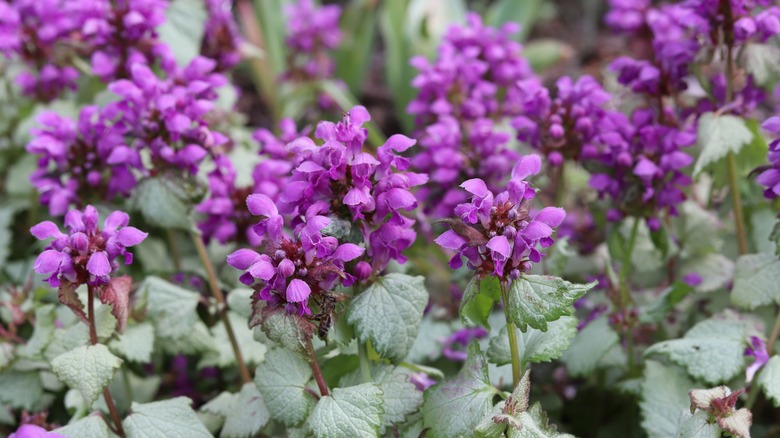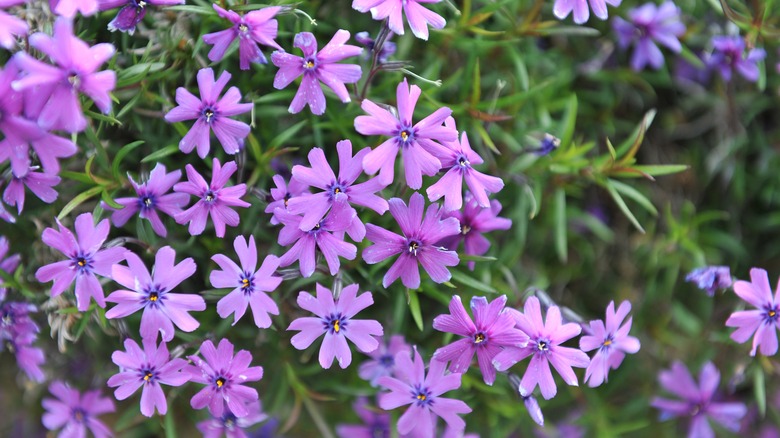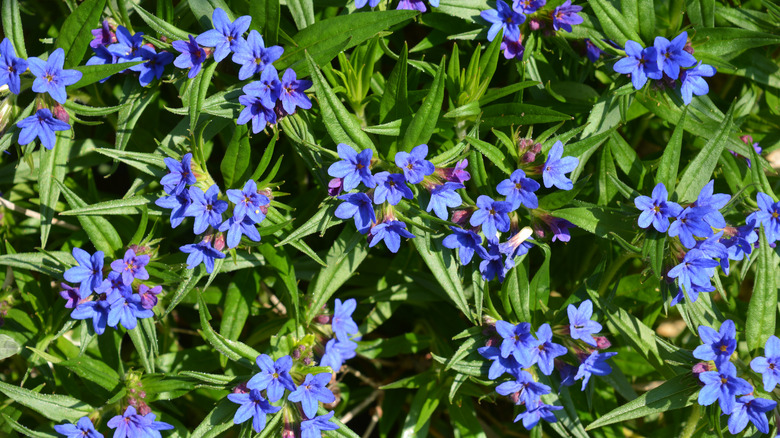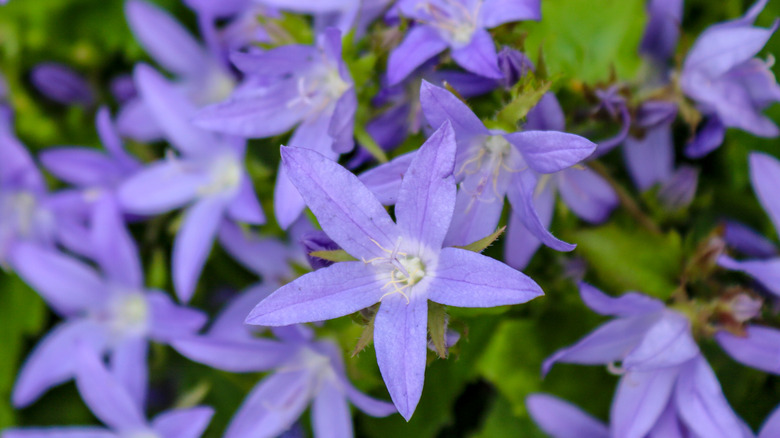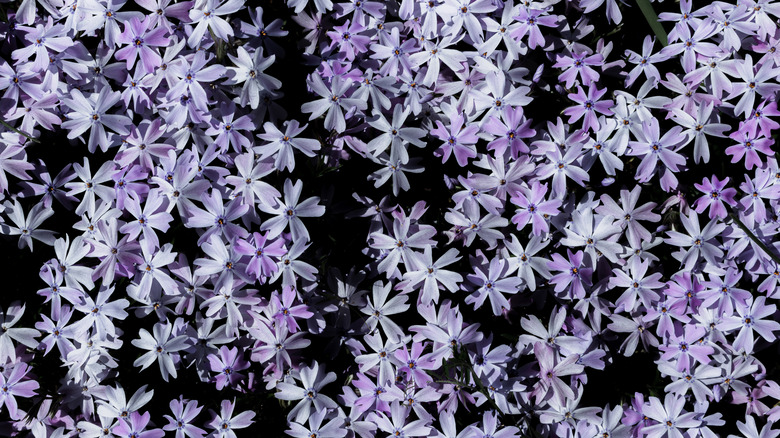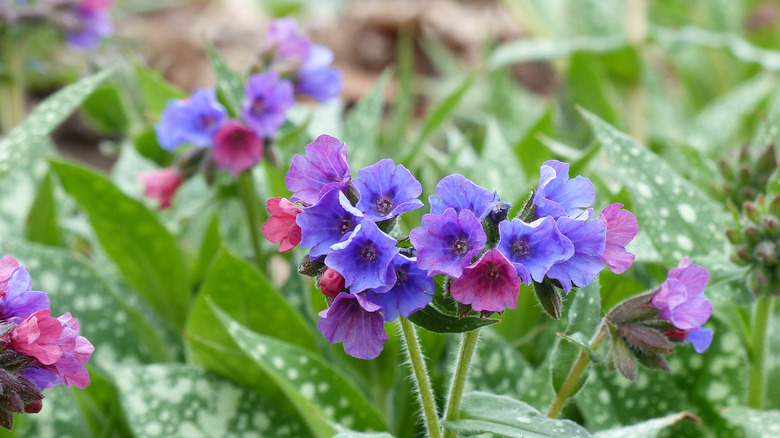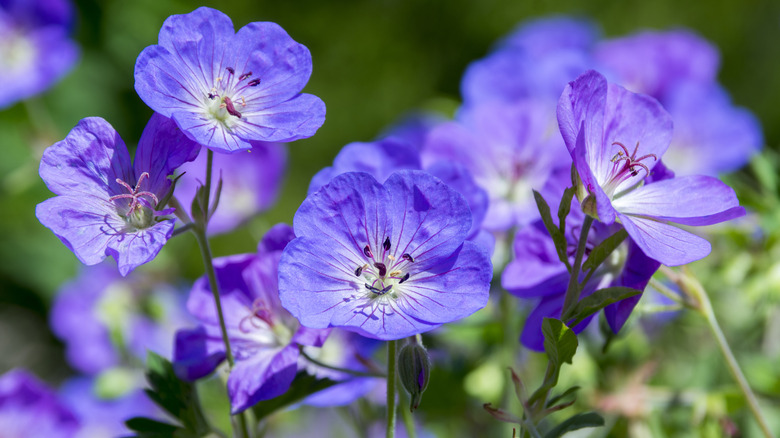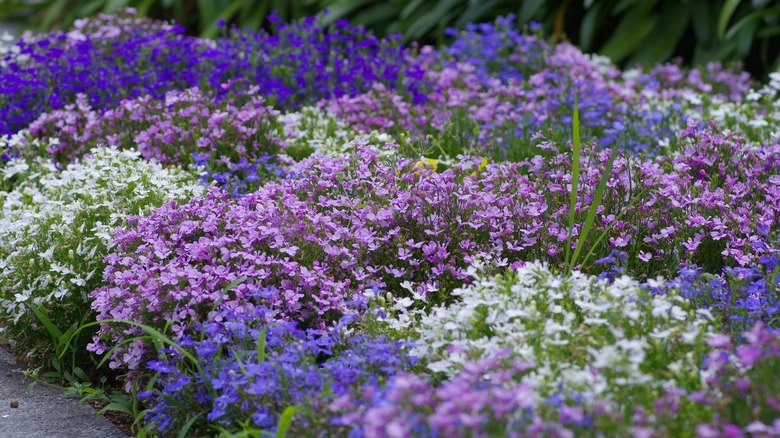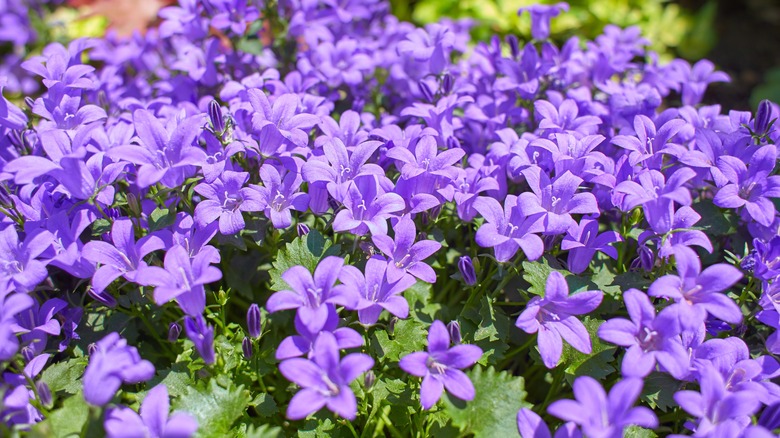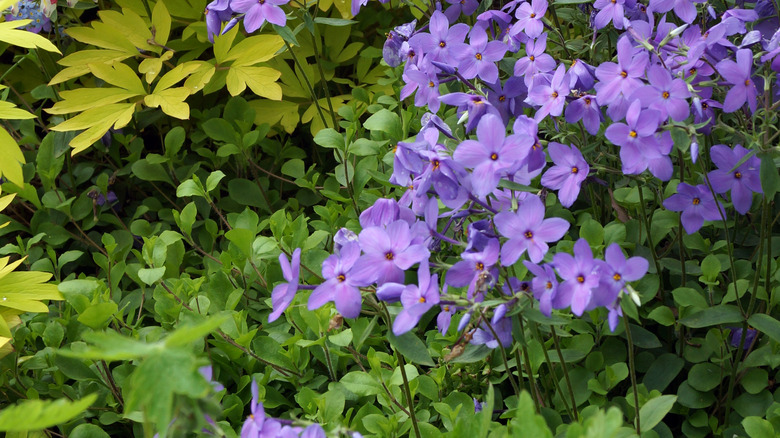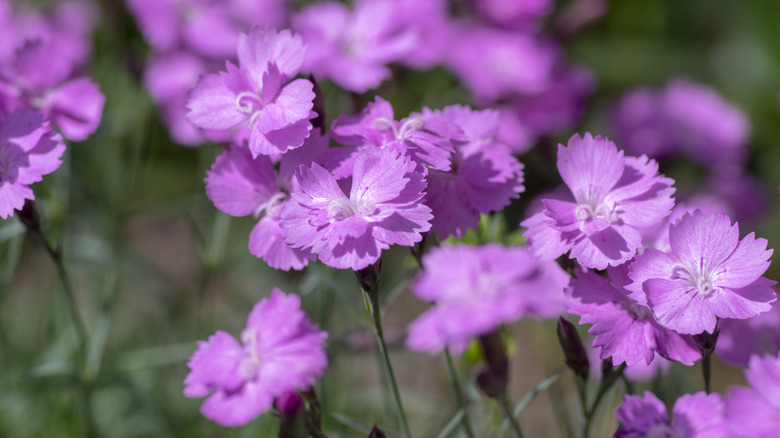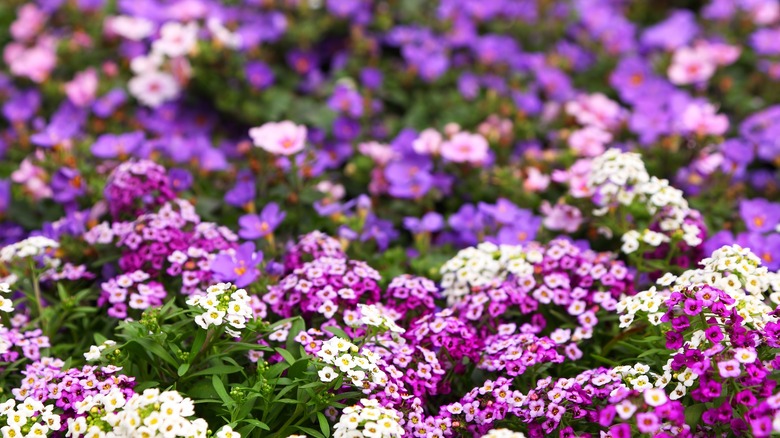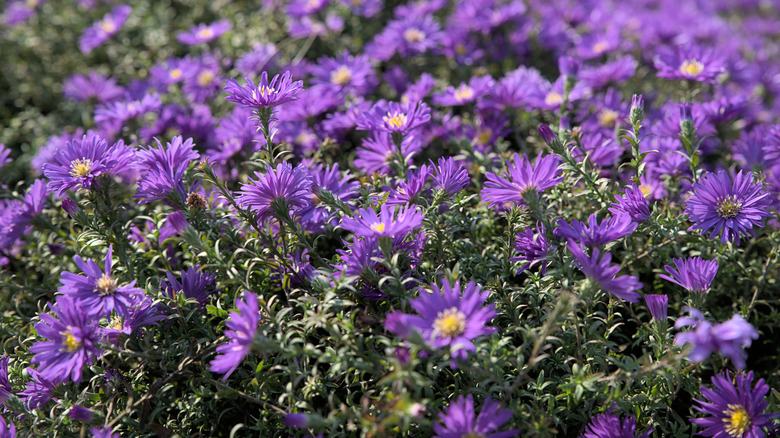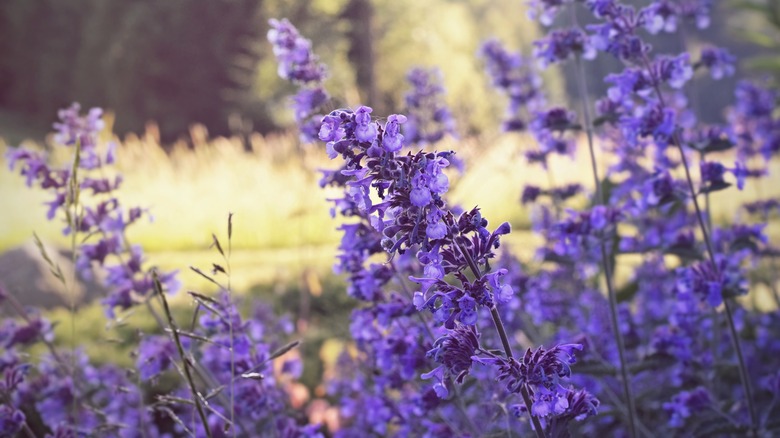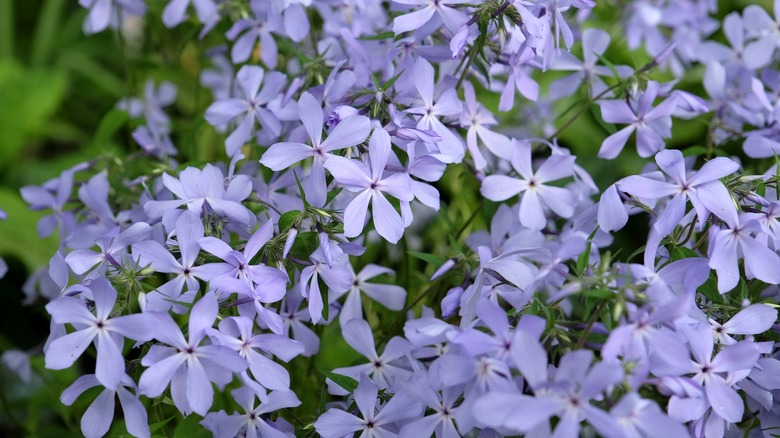Our Gardener Says These 15 Purple Flowering Ground Covers Will Add Gorgeous Color To Your Yard
Ground cover plants can be a real boon for the garden. They fill in space and are often low-maintenance plants. There are ground cover plants suitable for sunny and shady locations and for a range of climate and soil conditions. Flowering ground covers add some extra beauty during the growing season. We've gathered up a lovely assortment of 15 flowering ground cover plants in shades of purple to create some colorful drama in your garden. When planting flowering ground cover plants, you'll want to be sure to locate them in the best possible spot so they will continue to thrive over time. It's also a good idea to do some research beforehand to learn about any special growing conditions these plants have. While not invasive, some may spread themselves assertively, so you'll want to give them some room.
Consider the function of your ground cover plants before you choose them. Are they covering up bare spots in your lawn? Filling in a woodland shade area? Creating a border planting by a fence or walkway? Maybe you want some plants beneath a large tree. Or maybe you need some drought-tolerant plants that will thrive without much water in your desert rock garden. This assortment of plants is bound to have something suitable for your needs and covers a wide range of growing zones, light conditions, and water needs. They all have one thing in common: gorgeous purple flowers!
1. 'Purple Dragon' lamium
Lamium is a colorful shade-loving ground cover plant also known as dead nettle. The leaves are usually two-toned with pale and dark green stripes or edges. While some types of dead nettle can be considered a noxious weed (especially the yellow-flowering Lamiastrum galeobdolon or 'Yellow Archangel'), the specific 'Purple Dragon' cultivar with pinkish-purple flowers and eye-catching leaves spreads quickly but isn't invasive. It should be trimmed once or twice per season to keep it in check. Lamium can be grown in sun or shade and likes a well-drained loamy soil.
2. 'Purple Beauty' creeping phlox
Creeping phlox (Phlox sublata) is also known as moss phlox and is covered in small five petal flowers from mid-spring through early summer. The 'Purple Beauty' cultivar will spread fast, but it won't overtake other plants. It has vibrant flowers of orchid pink with a small violet eye. Creeping phlox blooms best in partial to full sun, and does well planted on the edge of flower beds, spilling over rock walls, or in sloped garden beds. Best of all, it's actually an evergreen plant to keep color in your yard all year long.
3. 'Heavenly Blue' lithodora
The 'Heavenly Blue' (Lithodora diffusa) has tiny, bright violet-blue funnel-shaped flowers with purple accents. It is a somewhat tender perennial, hardy in USDA growing zones 6a to 8b. This low-growing plant grows between 8 to 12 inches tall and forms a dense evergreen mat suitable for ground cover. This plant works well in rock gardens and is deer-resistant. It likes partial to full sun, well-drained soil, and lots of water in the summer. The flowers appear in mid to late spring and bloom for weeks throughout the summer.
4. 'Blue Waterfall' bellflower
The campanula, or bellflower, is a versatile garden plant. The 'Blue Waterfall' cultivar is a low-growing variety with small, pale purple star-shaped flowers that bloom profusely. Known by its botanical name Campanula poscharskyana, and also called the Serbian bellflower, it's a good choice as a ground cover, edge planting, or spilling over a rock wall in the garden. This bellflower blooms all summer, starting in late spring and continuing through early autumn. It's quite low maintenance, needing only regular watering in dry weather. Prune it back well after the first round of flowers to encourage fresh growth.
5. 'Violet Pinwheels' creeping phlox
This is a beloved creeping phlox, with pale violet flowers lending a soft pastel glow to your garden. As a ground cover plant, creeping phlox provides weeks of color and helps keep weeds out of your garden. Despite its hardy weed-suppressing form, it's not invasive, and needs only occasional trimming to keep it fresh. This cultivar of creeping phlox is not a Phlox sublata, but a Phlox x bifida: the difference is that the slender leaf blades are slightly longer than Phlox sublata, making the foliage a bit more prominent.
6. 'Mrs. Moon' lungwort
Lungwort (pulmonaria) is an attractive shade perennial that makes a nice spring-flowering ground cover. The foliage is striking, with pale green spots on medium green leaves. The lovely small trumpet-shaped flowers in spring for weeks, with colors ranging from pink to purple to deep blue, sometimes all at once. One nice purple variety is the cultivar 'Mrs. Moon.' Pulmonaria does well in a well-drained but slightly acidic soil that is somewhat moist but not soggy. The clumps grow larger via their small rhizomes and while it may occasionally reseed in the garden, pulmonaria is not invasive.
7. 'Rozanne' geranium
Perennial or cranesbill geraniums are a wonderful choice to plant in a cottage style garden. There are two forms: the shade-lovers that spreads via rhizome, and the ones that prefer a bit more sun and grow on tendrils from a central clump. Both make a good ground cover with sprawling flowers in a range of cool colors. The violet flowers of the 'Rozanne' geranium bloom for weeks in late spring, and if you deadhead them, you'll get a second round of flowers later in the season. Plant in partial to full sun with a well-drained, rich soil.
8. Trailing lobelia
Trailing lobelia (Lobelia erinus) is often grown as an annual, but in USDA growing zones 10 to 11 it's a tender perennial. The range of cool colors includes white, pale pink, lavender, periwinkle, and blue. If you want to plant annuals for ground cover plants, lobelia works well and blooms for the entire season. Deadheading and trimming spent flowers makes room for more buds to form. These colorful flowers attract butterflies and are unattractive to deer. However, they can droop a bit in very hot weather, so you will need to keep them watered to maintain their look.
9. 'Birch Hybrid' campanula
Also known as Campanula portenschlagiana and Dalmatian bellflower, this campanula is a low-growing ground cover plant with tiny brilliant violet cup-shaped flowers. It makes a great plant for a beautiful rock garden in your yard or tucked into crevices in rock walls. It's not fussy about soil and blooms well in partial sun or shade. The flowers bloom from late spring through late summer. Once the blooms fade, shear off the top third of the plant to keep the foliage looking fresh. Divide the 'Birch Hybrid' bellflower every three or four years.
10. 'Sherwood Purple' woodland phlox
Woodland phlox refers to two different species. They are both spring bloomers that spread new roots gently from their main clump. The 'Sherwood Purple' cultivar is a Phlox stolonifera and is shorter than its cousin Phlox divaricata (the 'Clouds of Perfume' variety mentioned below), growing to a height of 6 to 8 inches, and its flowers also have more rounded petals. It blooms in partial to full shade and increases in size slightly each year. Divide it when you divide your other perennials in the fall by digging it up and gently separating the root clump.
11. Purple dianthus
Dianthus flowers, also known as pinks, are an easy-to-grow cottage garden favorite. The blooms last for weeks and if deadheaded will form new buds. There are a few different types of dianthus with different growth habits. The Dianthus deltoides variety works best as a ground cover: the spiky blue-green leaves and flower stems spread out from the central root system. The range of colors is vast and new hybrids appear every year. Some wonderful purple cultivars include 'Delilah,' 'Everlast Violet Blue,' and 'Paint the Town Magenta.' Plant in full sun for the best flowers.
12. Sweet alyssum
Sweet alyssum is one of those annuals that often reseeds and becomes perennial in the right circumstances. It's a charming ground cover and even though the stems and leaves look delicate, they form a dense mat and prevent weeds from poking through. Plant sweet alyssum in a spot where it can spread in your garden, creating a colorful edge or filling in bare spots. The tiny flowers come in a wide range of colors from white to dark purple and many bi-colors. Some of the best purple alyssum varieties include 'Violet Queen,' 'Violet Knight,' and 'Royal Carpet.'
13. 'Woods Purple' aster
The 'Woods' aster cultivars are short, compact, spreading plants that provide weeks of color from late summer through autumn. They're a terrific ground cover for partial to full sun. They come in blue, purple, and pink varieties, and 'Woods Purple' is a medium slightly-reddish purple that provides vivid autumn color at a time when most garden perennials are starting to wind down. Plant these asters in a well-drained, loamy soil that stays fairly moist. This plant spreads by gently meandering through the garden and is easily controlled by simply lifting out rooted sections you don't want.
14. 'Cat's Pajamas' catmint
Flowering catmint is a colorful, fragrant perennial herb that comes in many varieties. The central clump of blue-green leaves can get quite large, and catmint makes an effective ground cover or weed-suppressing companion plant at the base of roses or other shrubs. The low-growing 'Cat's Pajamas' cultivar (Nepeta x faassenii 'Cat's Pajamas') is a petite version with flower spikes growing about 12 inches high. Deadheading the spent blooms will encourage reflowering. It likes a sunny spot with sandy soil. Cats do enjoy eating catmint and will react to it much as they do catnip.
15. 'Clouds of Perfume' woodland phlox
'Clouds of Perfume' woodland phlox (Phlox divaricata) is a spring-blooming phlox that usually grows about 12 inches tall. It has large pale periwinkle blue flowers in starry shapes that add lightness to the spring flower garden. This is an older variety, winter hardy, and a reliable spring bloomer. It grows steadily but is not invasive and can be divided easily to plant throughout your garden. This woodland phlox blooms in partial shade to full sun and likes a rich, moist (but not soggy), and well-drained soil.
